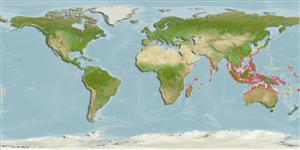Environment: milieu / climate zone / depth range / distribution range
Ecologia
marinhas; estuarina demersal; intervalo de profundidade 3 - 15 m (Ref. 90102). Tropical
Indo-West Pacific.
Tamanho / Peso / Idade
Maturity: Lm ? range ? - ? cm
Max length : 10.2 cm SL macho/indeterminado; (Ref. 1623)
Descrição suscinta
Chaves de identificação | Morfologia | Morfometria
Espinhos dorsais (total) : 6 - 7; Raios dorsais (total) : 9 - 10; Espinhos anais: 1; Raios anais : 8 - 9. Characterized by semi-translucent grey body with brown and white spotting; lower side of body with row of double blackish spots; pelvic fins united and frenum present; rounded caudal fin, about equal to head length; longitudinal scale series 22-26; ctenoid body scales and on nape; predorsal scales 8-11; cheek and opercle without scales; depth of body 5.5-6.1 in SL (Ref. 90102).
Solitary or in small groups. Inhabits sand-rubble bottoms in 3-15 m (Ref. 90102).
Ciclo de vida ou comportamento de acasalamento
Maturidade | Reprodução | Desova | Ovos | Fecundidade | Larvas
Goren, M. and M. Dor, 1994. An updated checklist of the fishes of the Red Sea (CLOFRES II). The Israel Academy of Sciences and Humanities, Jerusalem, Israel. 120 p. (Ref. 12541)
Status na Lista Vermelha da UICN (Ref. 130435: Version 2024-1)
Ameaça para os humanos
Harmless
Uso pelos humanos
Ferramentas
Relatórios especiais
Baixar XML
Fontes da internet
Estimates based on models
Preferred temperature (Ref.
123201): 25.2 - 29.3, mean 28.6 °C (based on 2838 cells).
Índice de diversidade filogenética (Ref.
82804): PD
50 = 1.0000 [Uniqueness, from 0.5 = low to 2.0 = high].
Bayesian length-weight: a=0.00692 (0.00374 - 0.01278), b=3.05 (2.89 - 3.21), in cm total length, based on LWR estimates for this species & (Sub)family-body (Ref.
93245).
Nível Trófico (Ref.
69278): 3.4 ±0.4 se; based on size and trophs of closest relatives
Resiliência (Ref.
120179): Elevada, tempo mínimo de duplicação da população menor que 15 meses (Preliminary K or Fecundity.).
Fishing Vulnerability (Ref.
59153): Low vulnerability (10 of 100).
